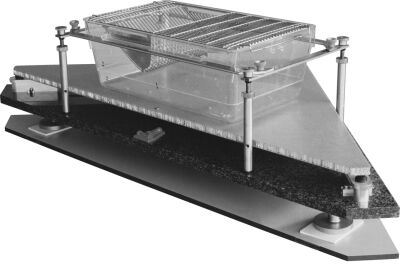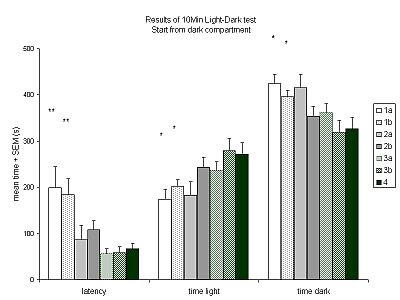
Measuring behaviour of transgenic mice by using the LABORAS system
M. van der Meer1, H.E. Molewijk2, V.Baumans1 and L.F.M. van Zutphen1
1Department
of Laboratory Animal Science, Utrecht University, Utrecht, The Netherlands
2Metris b.v., Hoofddorp, The Netherlands
This study evaluates the effects of biotechnological procedures involved in the process of microinjection-induced transgenesis in the mouse. We have compared four groups of C57BL/6 mice which differ in their transgenic history (transgenics after integration of a functional corticotrophin-releasing factor (CRF) gene construct, transgenics after integration of a non-functional CRF gene construct, non-transgenics after transgenic procedures, controls). These four groups have been tested in a 10 min light-dark test and a 24 h behavioural observation test, both using the automated behaviour registration system LABORAS™ (Laboratory Animal Behaviour Observation, Registration and Analysis System; Metris b.v., Hoofddorp, The Netherlands) presented previously at this conference [1]. With this system, the position and the six behavioural categories immobility, locomotion, grooming, climbing, eating and drinking can be deduced from the vibration patterns evoked by the individual mice. The system was recently adapted to accommodate a light-dark test cage and to analyse the data accordingly.

Figure 1. Regular LABORAS sensor platform.
The tests revealed differences in behaviour between the transgenic CRF animals and the controls; transgenic CRF animals showed more anxiety in the light-dark test and less locomotion, more immobility and less climbing behaviour during the 24 h individual observation test than the controls. For the other two groups no significant differences from control animals were found. Neither the integration of a DNA construct into the genome (without gene expression) nor the biotechnological procedures of microinjection seem to have a major effect on the behaviour of the mice. Previous results, obtained by screening the animals in the pre-weaning period substantiate these observations. The behavioural tests used in this study seem to be sufficiently discriminative to differentiate between the treatment groups and the controls. Thus, it is concluded that LABORAS can be used for behavioural phenotyping of newly produced transgenic lines.

Figure 2. Results of 10 min light-dark experiment. Group 1: Corticotropin-releasing factor (CRF) transgenics with functional CRF construct (1a and 1b represent progeny from two different founders); Group 2: CRF transgenics with non-functional CRF construct (2a and 2b represent progeny from two different founders); Group 3: non transgenics after transgenesis (3a, injected with DNA construct, no integration; 3b, transgenic procedure, but no construct injected); Group 4: control animals (no transgenic treatment). Latency to first entry in dark compartment, total time spent in light and dark compartment (mean sec plus/min SEM) are shown. Test period was 10 min. * p<0.01, **p<0.001, significant difference compared to the control group).
Poster presented at Measuring Behavior 2000, 3rd International Conference on Methods and Techniques in Behavioral Research, 15-18 August 2000, Nijmegen, The Netherlands